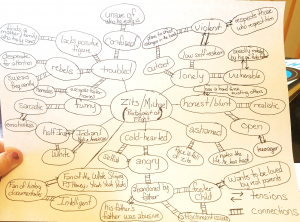Kirsten Schlorff
30 November 2015
Love Squared: Insight into the Life of an Identical Twin
Dear Reader,
Writing and compiling this essay has not been an easy process to say the least. Growing up, people always asked me what it was like being a twin, but I never really gave them an answer beyond, “well it is great sometimes yet horrible at others.” It is a complex question really, because no one else truly comprehends the experience unless they are also a twin. I have hidden the true, much deeper response to this question as a dark secret over the years. In a way, writing about my relationship with my twin is a form of public humiliation. It cuts to the inner core of who I am, and who Alison and I are as twin sisters. Yes, we are identical twins, even though we definitely do not look or act exactly alike as we once did.
I knew that in order to be completely honest in examining my “twinship” with Alison, I couldn’t tell the perfect story of dressing alike, confusing boyfriends, or trading places. Being an identical twin includes all the clichés: having an unwavering life partner, knowing the exact feelings of another person, wanting her to be the first to hear your story, respecting her opinion before anyone else’s, and physically experiencing someone else’s raw emotions. Alison has always been there for me, from the very first breath of air that I took. Never once have I been alone. We were welcomed into this world as a package deal—becoming each other’s playmate, sidekick, supporter, advisor, and biggest fan. It is hard explaining to other people that we could never hate each other, though we constantly fight and intensely argue; that we wouldn’t handle other people judging one of us, even though we are cruelly judgmental of each other; that we always want to tell each other everything, regardless of whether we are two hours away or just across the hall.
Here are some important facts you should know about Alison and I’s “twinship”:
- We were born on October 1, 1996 at Williamsport Hospital in Williamsport, PA.
- Our mom conceived and delivered us naturally, incredibly rare for twins these days.
- Alison was born six minutes before me and she has never let me live it down. I should have been born first, but I was breech and suffered a broken clavicle.
- We are each other’s only biological sibling.
- My mom wrote our names, Alison and Kirsten, in her Bible far before she even discovered she was expecting twins. (1)
Sincerely,

Kirsten Schlorff

(2)
“Friends Yet Enemies”
She’s my twin sister.
My best friend since day one.
No one else can understand me quite like she can.
Through good times and bad, we are each other’s shoulder to cry on.
She’s supported me through breakups, lost friendships, and even losing loved ones.
It’s so much different here at college, without being associated with my twin.
Never imagined I would miss her this much.
Love you Al! <3
She’s my twin sister.
My biggest competition since birth.
Arguments between us are relentless, it’s like fighting with yourself.
There are times when she frustrates me so much that I wish she didn’t exist.
We may yell and scream, but the hardest hit determines who wins the fight.
Despite the arguments and tears, it isn’t the same at home without her here.
Never imagined I would miss her this much.
Love you Kirst! <3

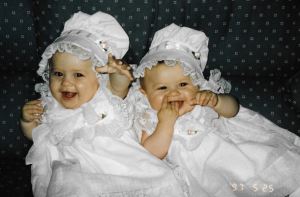
Alison and I were baptized when we were about eight months old. Even as babies, we were never camera shy. (Kirsten on left; Alison on right)
Being a Twin
What is it like having a twin sister? People constantly ask me this, but I do not blame them for their curiosity of the unknown. It is a complex relationship—a rare bond that few individuals can fully understand. Someone who looks exactly like me. Identical. Nine letters that almost reveal identity. Clone. Always being called the wrong name. Mistaken. Two separate identities that combine to form one. Schlorff. Twins. Sounds desirable to those who haven’t actually experienced it first-hand. Not as great as movies like the Parent Trap make it look. Sharing is automatically assumed. Everything. My half. Her half. Together equals one. Unfair. Trapped. Inside the identity of a twin. When will I become whole?
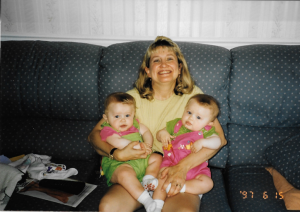
Twins are double the trouble, but Alison and I were also double the blessing. (Alison on left; Kirsten on right)

At two years old, we looked and dressed exactly alike. Most of our toys were even the same. (Alison on left; Kirsten on right)
Being Kirsten’s twin sister is definitely very unique and special. We have become each other’s best friends, not only twin sisters. Having a twin, is like having a best friend live with you. She is usually the first to know when I need help with something school-related, or even when I simply ask her for advice. I would describe Kirsten as very determined and motivated. She also has an incredibly uplifting spirit to support me when I am going through rough times. She has her mind set on being successful in life, and I doubt she will settle for anything less than what she deserves. I consider myself lucky to have been blessed with a twin sister, because she has been my best friend since birth.
–Alison (3)

(4)
My Family Tree

Image created using “Geni”
The number of twins in the U.S. continues to multiply every day. According to a 2012 report by the National Center for Health Statistics, the birthrate of twins rose 76 percent from 1980 to 2009 (Jacques). Identical twins are conceived when a single embryo splits in two after fertilization. Therefore, identical twins have matching DNA, because they came from the same fertilized egg (O’Connor).
Because twins share the same DNA, most people think that their fingerprints must be identical, which is only a falsified myth. Fingerprints are not solely produced based on DNA. When identical twins are conceived, they start out with the same fingerprints. As the babies start to move and each touch the amniotic sac, unique ridges and lines are formed on each twin’s hand resulting in different fingerprints (Jacques).
Embryo splitting occurs randomly, so identical twin births don’t run in families and genes are not an influencing factor. Having twins can become a trend in families, but it doesn’t necessarily bypass generations. However, a couple has an increased likelihood of having twins if there is a trace of twins within the maternal side of the family (O’Connor).
As depicted in my family tree, there is no trace of twins on neither the maternal nor the paternal sides of my family. Born as identical twins, Alison and I were exceptionally rare in our family because we were the first set of twins. When my mother first found out she was expecting twins, she was completely shocked. Nineteen years later she says, “Even though it was totally unexpected at the time, having identical twin daughters was the best thing that ever happened in my life” (Schlorff, Rhonda B).
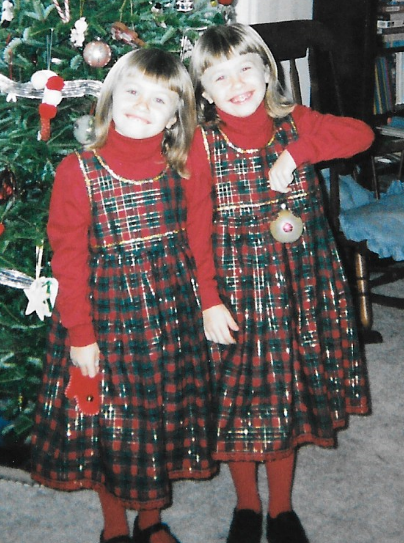
Even though we still dressed identically, our different facial structures made it easier to tell us apart when we were in first grade. (Alison on left; Kristen on right)
Who’s Who?
| Top 5 Differences |
Top 5 Similarities |
| 1. Our facial structure (Alison’s face is more round-shaped) |
1. Voice (sounds exactly the same over the phone) |
| 2. Height (I’m 5’7”, Alison’s 5’5”) |
2. Laugh (quiet, identical) |
| 3. Weight (I’ve weighed more from birth, now only about 5 lbs. difference) |
3. Intelligence (graduated 3rd and 5th in our high school class) |
| 4. Personality (I’ve always been more outgoing, Alison’s been more shy) |
4. Friends (same friends we’ve known since 4th grade) |
| 5. Interests (I performed in musicals and sang in choir, she played soccer) |
5. Clothing Sizes ( but we never share clothes) |
Alison and I’s differences and similarities help to characterize and connect us as identical twins. However, our twin sister bond has never been that concrete, because it surpasses what we share in common and what we do not. The “twinship” we form together amounts to a relationship far greater than the sum of our individual personalities.
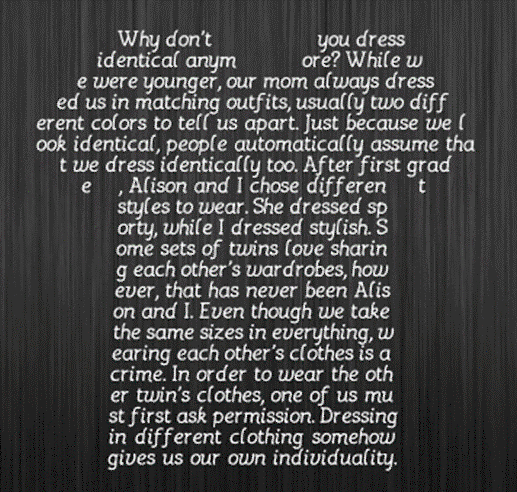
Image created using “ImageChef”


In high school, it was a rare occasion that Alison and I chose to dress alike. Even in our senior pictures, we wanted to dress differently. Wearing different clothes makes it easier for people to tell us apart from each other. (Left picture-Kirsten on left; Alison on right, Right picture-Alison on left; Kirsten on right)

Alison and I have been best friends with Chyann and Kaitlyn Jewell since fourth grade. They are also identical twins, and are only about a month younger than we are.
Q: What is it like being a twin? (5)
Chyann
A: Being an identical twin isn’t as easy as it seems. Bring two humans that look the same, act the same, talk the same, and think the same together, and there is bound to be issues. There are times when I love having a twin sister, because I will always have a life-long friend. However, having a twin sister sucks at times, especially when you get into arguments. You are constantly fighting with your mirror image! Even though Kaitlyn looks exactly like me, we will never have the same personality or hobbies. I tend to be more outgoing and talkative than she is, but she beats me at every sport and reads more often than I do. Kaitlyn also enjoys cooking and spending time alone. Hands down, I can beat her in any argument!
Kaitlyn
A: As twins, my sister and I usually argue 24/7 over the stupidest things. We tend to be very competitive, especially with grades and friends. There are good days and bad days. Somedays I love having a twin, but there are others when I absolutely hate it. We may look identical, but we have very different personalities. Chyann is more sociable and dominant than I am, and she tends to boss me around at times. By now, we know how to push each other’s buttons and that’s when her stubbornness comes out. Regardless of our differences, we will always have each other to count on for anything. Twins have an indestructible bond that is complicated for other people to understand.
Spreading My Wings
Every high school senior planning to attend college knows the stress of completing college applications, hoping to get accepted to the right one. During this process, many students wonder which school is the best fit. Being a twin only made this process harder for me. I already knew I wanted to major in journalism and after visiting the campus, I fell in love with Indiana University of Pennsylvania. However, this college was over two hours from home and Alison wanted to commute to Lock Haven University. We had never been separated from each other for a prolonged period of time, so our relationship would take on a whole new meaning in the fall. I grew increasingly more nervous as the start of the upcoming school year was just around the corner, rethinking and questioning whether I had made the right decision. Maybe if I had chosen a different major, I could stay at home too and wouldn’t have to leave.
When the day finally arrived to drive out to IUP and move into my dorm, I was torn apart emotionally. I was leaving my twin sister, my best friend, my partner in crime behind at home, as I went off to college to begin my new future. Although most twins prefer to stay together through college, there are some like Alison and I, who decide it is best to venture off in different directions. In a way, going to college at IUP without my twin sister, has given me a sense of individuality that I never had back home. Everyone just called us both, “Schlorff” or “Schlorff Twins,” because they could never tell who was who. At college, no one knows that I have a twin sister, unless I tell them about her first. For once, it feels rewarding to hear my own name, to finally be called Kirsten. (6)

As twin sisters, Alison and I share the same group of friends we’ve known since 4th grade. Deciding to follow my dream career in journalism and attend IUP two hours away, required me to leave behind both my identity as an identical twin and my best friends.
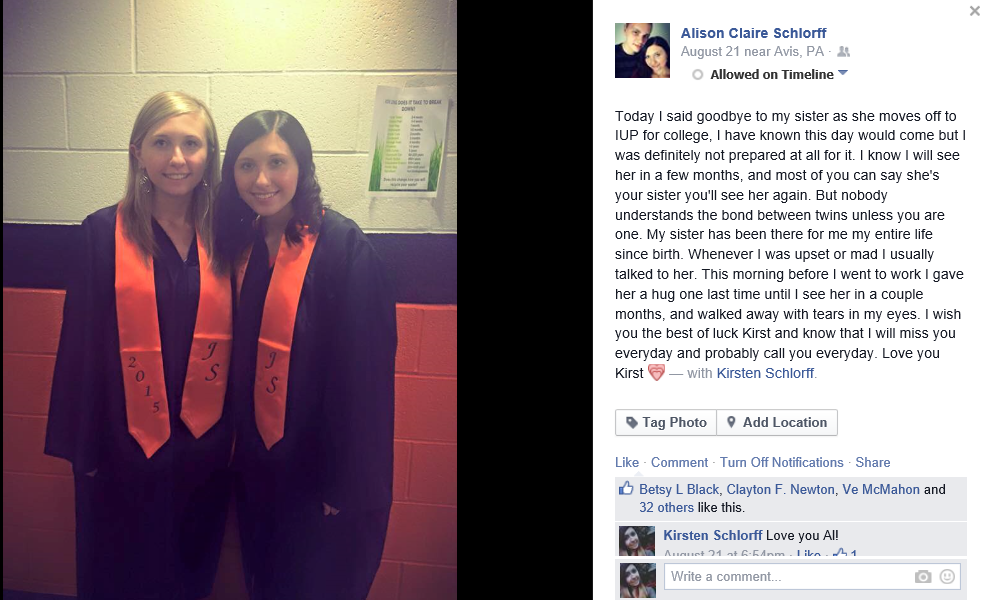
(7)
College Separation
In the everyday rush of the college lifestyle, I rarely get the opportunity or freedom to relax. School work consumes my life and I find myself lost in a whirlwind with no time to spare. Little time exists to think about people from back home, even if it’s my twin sister, my other half. Texting each other a few times during the week is sufficient, although I wish I had enough time to catch her up on everything happening in my life. Wakeupshowerclasseslunchmoreclassesdinnerhomeworklimitedsleep. Repeat. Within a few weeks of my transition into college, my twin gradually became more and more like a stranger than my best friend. There was no time to tell each other every minute detail, like we had growing up together for 18 years. Our lives grew busier and we slowly drifted apart. Every time I leave home it is harder to leave behind my family and twin, in order to live my other life at college. Even though only two hours separate us, it feels as if we are years apart maturing in our independent ways—twin sisters becoming less identical with the passing of time.
Dear Al,
No matter how far the distance separating us from each other is, my love for you will never change and I want you to always remember that. I am grateful to have been blessed with you as my best friend, from the very first moment I entered this world. There are not many people who can say someone has “had their back” since they were born, but that is one thing that will always remain true between us. Regardless of what paths we take in each of our lives, what decisions we make, where we decide to settle down one day, who we decide to marry, or what future career we pursue, know that I will fully support you.
I know that growing up with me as your twin sister has not always been easy. There have been times when I have screamed at you at piercing volumes just to get my point across, and others when I physically fought with you trying to slap some sense into you. Despite our countless altercations over the last nineteen years, I hope you realize that I never meant to hurt you. All I have ever wanted is the best for you, because even when you do not see the successful potential you possess, I do. In your future, various people and things will try to hold you back and prevent you from attaining this success. Ignore them. Don’t settle for anything less than you deserve in life, whether it be in relationships, school, or even your career one day. If you are not happy, makes changes so that you are. As selfish as it sounds, sometimes it is necessary to value your happiness before others. After all, in order to truly love someone else, you must first love yourself.
College has brought new experiences for each of us, especially with living two hours apart from each other. I know there are times when you miss me being at home, and others when you are thankful I am no longer there. Whether I am at home or far away, I will always love you and you will forever be my best friend and partner in crime.
Love your other half,

PS: Some things are meant to be, the tide turning endlessly,
The way it takes hold of me, no matter what I do.
And some things will never die, the promise of who you are,
The memories when I am far from you. <3 (8)
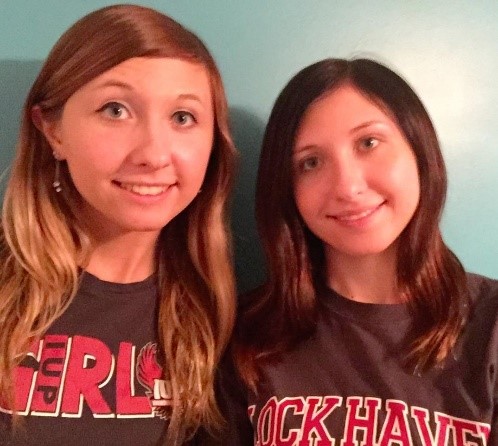
This is what my twin sister Alison and I currently look like. Though we no longer physically appear identical to each other, we will always be identical twins.
Notes Page
- Opening Letter- While trying to find exactly the right words to communicate what Alison and I’s unique twin sister relationship is like, I stumbled across the book, One and the Same: My Life as an Identical Twin and What I’ve Learned about Everyone’s Struggle to Be Singular written by Abigail Pogrebin. Every other book I found online about twins just skimmed the surface, and none of them actually provided inspiration or a deeper meaning behind the experience of being an identical twin. After I read the introduction of Pogrebin’s book, I was left speechless because it was like she had stolen the words right out of my mouth. Because she is an identical twin herself, she is able to describe in vivid detail what life is like having a twin sister. For this reason, I chose to model my opening letter to the reader around various parts included in this introduction.
- Twin Sister Quote- I wanted to include a quote that both summarized and described a twin sister in a broader context, since I also included my own descriptions of my twin sister Alison. While browsing through quotes on Pinterest about twins, this one stood out to me immediately, because it uses a metaphor to compare a twin sister to a mirror revealing future possibilities. Prior to reading this quote, I had never thought about my twin sister from this perspective, even though it is a very accurate comparison.
- Alison’s Note- Rather than just writing from my own perspective about Alison and I’s relationship as identical twins, I felt her thoughts should also be included. Because I’m away at college, I asked her to email via email what it was like to be my twin sister. I wanted readers to understand both of our feelings, not just mine.
- Best Friends Since Birth- On my way to class one day, I received a notification that my sister had posted this old image of us as toddlers, on Facebook with the caption “Best Friends Since Birth.” It was completely random and surprised me, but it let me know that she still misses me while I’m away from home. This picture also illustrates how identical we looked when we were younger.
- Q&A- I chose to interview my best friends, Chyann and Kaitlyn Jewell, who are also identical twins, in order to establish a broader context of identical twin relationships. Although Alison and I are identical twins, not every pair of identical twins acts exactly the same or has the same relationship. I asked both Chyann and Kaitlyn to explain what it is like being a twin and describe their twin sister. In identical twin sisters, one of the twins is usually more dominant and bossy than the other. Chyann is the dominant twin in her relationship with Kaitlyn, and I am the dominant twin in my relationship with Alison.
- Spreading My Wings- While writing this narrative piece about my transition to college and separating from my twin sister, I incorporated findings from a scholarly article titled “College-Age Twins: University Admissions Policies.” This article concluded that while most twins prefer to be together through college, there are also some who do not. There is no single solution that will apply to all sets of twins. Deciding which college to go to is also harder for twins because they have to decide whether it is in their best interest to stay together or separate. Because I chose to major in journalism and IUP felt like home, I had to separate from Alison.
- Today I Said Goodbye- Saying goodbye to my twin sister, who I had never been separated from longer than a week, was more difficult than I could have ever imagined. After I left that day, Alison posted this status on Facebook and it describes exactly how she felt having her twin sister move away. Because I included my feelings in a narrative piece on how it felt leaving Alison behind when I went off to college, I felt it was necessary to include her perspective as well.
- PS Song Lyrics- I concluded my final letter to Alison with these lyrics from the song, “Some Things Are Meant To Be” from the musical Little Women. I performed in a production of this musical during my sophomore year of high school, and these lyrics always reminded me of my relationship with Alison. In the show, Beth and Jo who are sisters, sing this song together before Beth dies. Beth isn’t afraid to move on because she knows she is loved by everyone, including Jo. Regardless of where our future lives take us, I know that I will always love Alison.
Works Cited
Foster, Sutton, and Meg McGinnis. “Some Things Are Meant To Be.” Little Women The Musical Original Broadway Cast Recording. CD. Ghostlight Records. 2005. Metro Lyrics, 15 Nov. 2015.
Jacques, Renee. “11 Facts About Twins That Make Them Even Cooler Than You Already Thought.” The Huffington Post. TheHuffingtonPost.com, 27 Mar. 2014. Web. 12 Nov. 2015.
Jewell, Chyann, and Kaitlyn Jewell. E-mail Interview. 9 Nov. 2015.
Nicolson, Laura. Being a Twin. Digital Image. Pinterest. N.p., n.d. Web. 12 Nov. 2015. <https://www.pinterest.com/pin/315181673896296119/>.
O’Connor, Anahad. “The Claim: Twins Always Skip a Generation.” The New York Times. N.p.,
2 Oct. 2007. Web. 12 Nov. 2015.
Pogrebin, Abigail. “Introduction.” One and the Same: My Life as an Identical Twin and What I’ve Learned about Everyone’s Struggle to Be Singular. New York: Doubleday, 2009. 11-16. Print.
Schlorff, Alison. “Best friends since birth.” Facebook. 16 October 2015. Web. 8 November 2015.
Schlorff, Alison. E-mail Interview. 10 Nov. 2015.
Schlorff, Alison. “Today I said goodbye to my sister as she moves off to IUP for college.”
Facebook. 21 August 2015. Web. 8 November 2015.
Schlorff, Rhonda B. Phone Interview. 14 Nov. 2015.
Segal, Nancy L. “College-Age Twins: University Admission Policies / Twin Research: Birth Weight And Neuromotor Performance; Transfusion Syndrome Markers; Vanishing Twins And Fetal Sex Determination; Mz Twin Discordance For Wilson’s Disease / Media: Big At Birth; Planned Separation Of Conjoined Twins; X Factor Twins; Cinema: The Identical.” Twin Research and Human Genetics: The Official Journal of the International Society for Twin Studies 17.6 (2014): 594-598. MEDLINE with Full Text. Web. 7 Nov. 2015.

